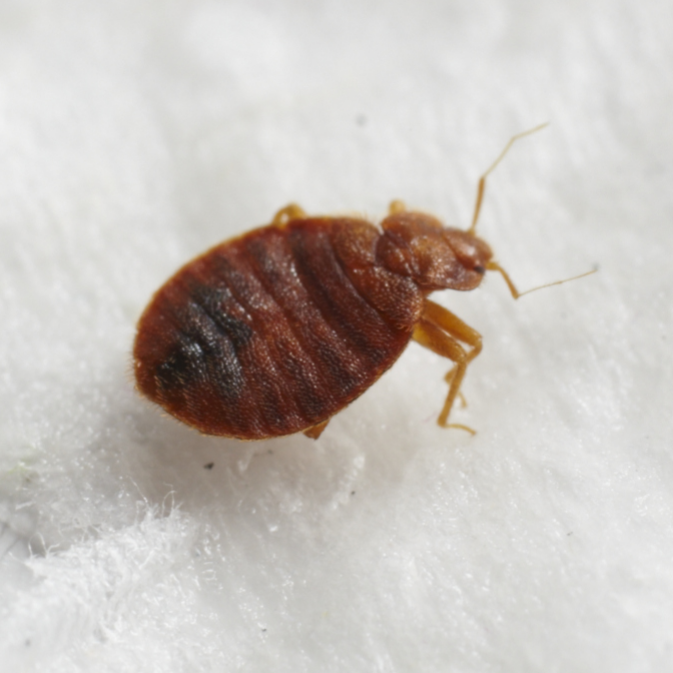
Female adult bed bug
With a little practice you can spot the difference between the male and female bed bugs; the female has a slightly rounded rear end.
Courtesy of anonymous www.Bedbugger.com forum poster
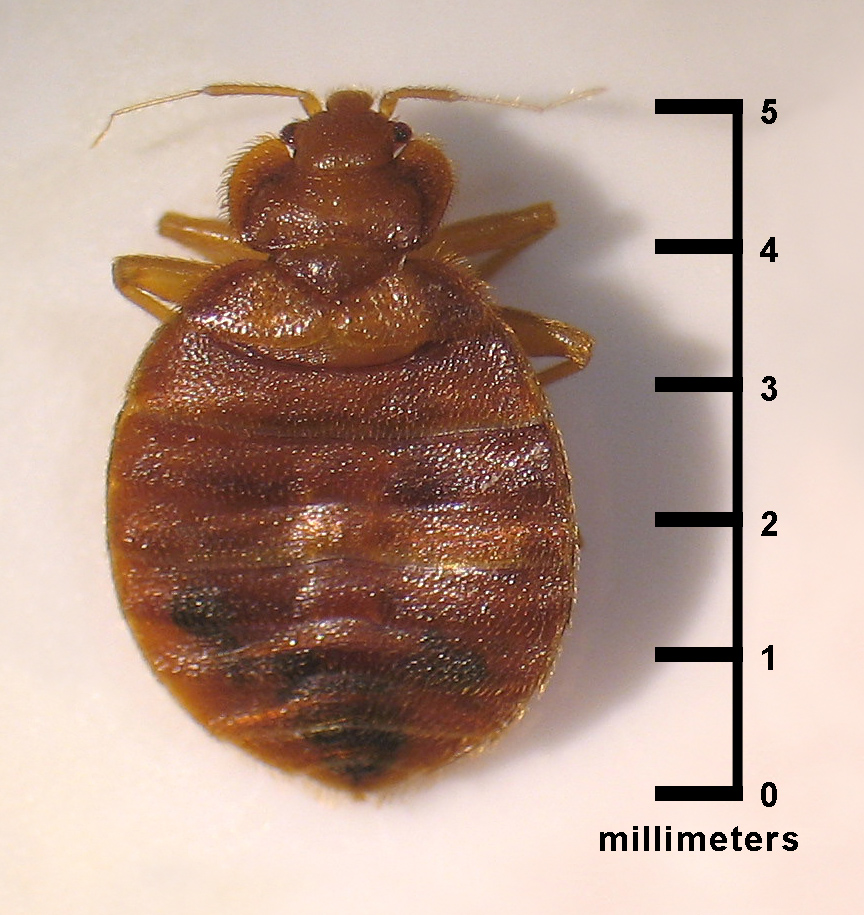
Dorsal view of an adult, Cimex lectularius bed bug.
Adult bed bugs are on average 5 mm long, oval-shaped and dorso-ventrally flattened. Like other members of the order, Hemiptera, they possess piercing-sucking mouthparts. Adults are brachypterous; the hindwings are nearly absent and the forewings are reduced to small, leathery pads. As you can see here, nymphs look like smaller, paler versions of the adults.
Courtesy CDC/ CDC-DPDx; Blaine Mathison/2010
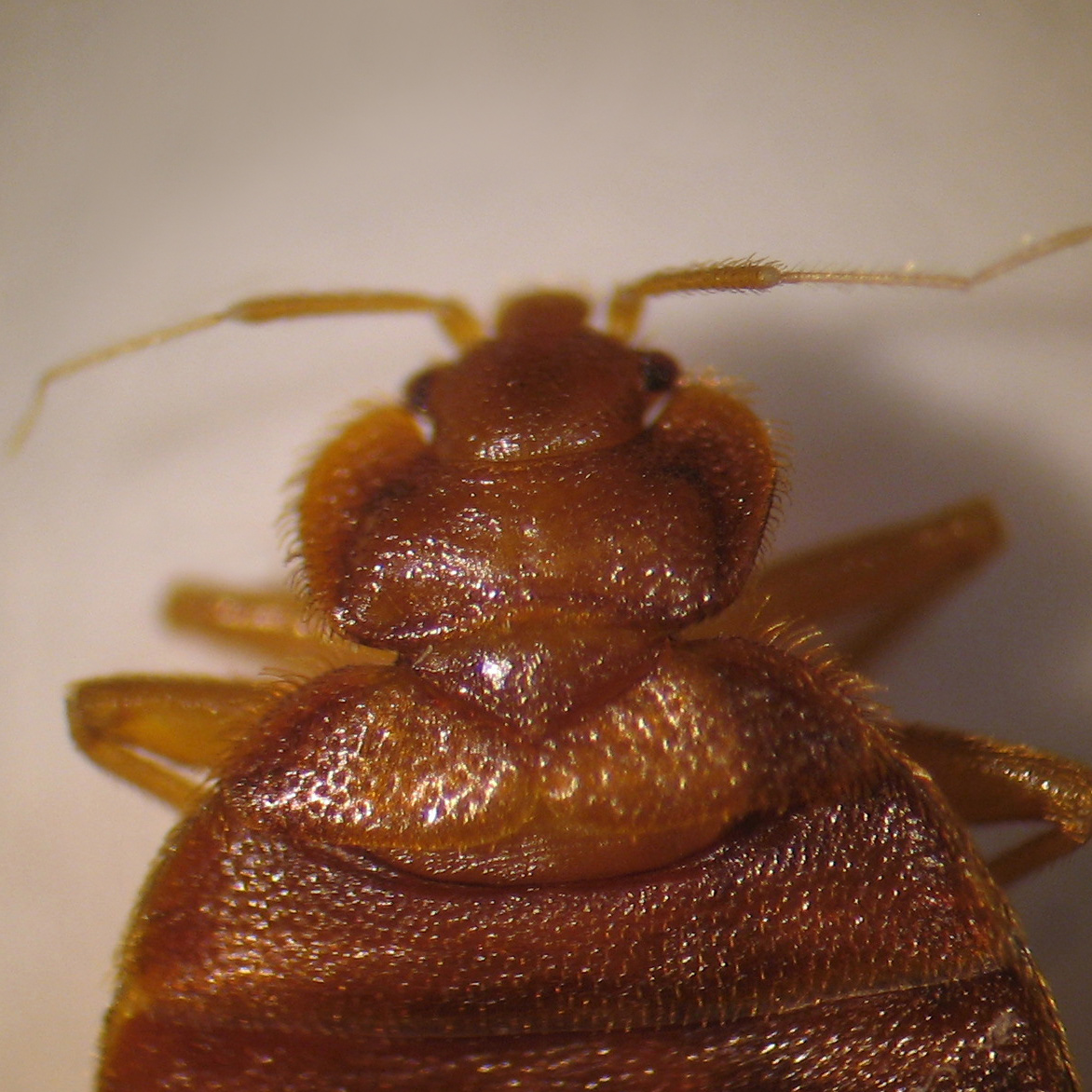
Dorsal View of Bed Bug Head Shot
Adult bed bugs are on average 5 mm long, oval-shaped and dorso-ventrally flattened. Like other members of the order, Hemiptera, they possess piercing-sucking mouthparts. Adults are brachypterous, which means that the hindwings are nearly absent, and the forewings are reduced to small, leathery pads.
Courtesy of CDC/ CDC-DPDx; Blaine Mathison/2010

Bed Bugs VS Apple Seeds
Male and female adult bed bugs in both unfed and fed conditions playing around their plant part look-a-likes, apple seeds. They can't tell the difference either and readily crawl over the apple seeds in a manner similar to what they do in their harborages. Both male and female bed bugs can have elongated abdomens after feeding. Males did not try to mate with the apple seeds. Any pale or dark waste droppings are from the bugs. Apple seeds don't move much at all, they have no legs. They are plump, but haven't fed. Blue line squares are 1/4 inch size. You must realize by now that I don't like to describe bed bugs as looking like apple seeds. Bed bugs look like bed bugs. It's important to familiarize yourself with good images of nymph and adult bed bugs, their waste material, and their shed skins to be able to properly identify unknown insects you may come across in your home or while on the road.
Notes and photo courtesy of Lou Sorkin

Male and Female Bed Bug
This photograph depicts a dorsal view of two bedbugs, Cimex lectularius. A male C. lectularius on the left, and a female on the right. Note the male’s slightly-pointed distal abdomen, where in females, it is rounded. Females are slightly larger than males in their lengthwise measurement.
The common bedbug C. lectularius is a wingless, red-brown, blood-sucking insect that grows up to 7 mm in length and has a lifespan from 4 months up to 1 year. Bedbugs hide in cracks and crevices in beds, wooden furniture, floors, and walls during the daytime and emerge at night to feed on their preferred host, humans.
Bedbug bites can result in clinical manifestations; the most common are small clusters of extremely pruritic, erythematous papules or wheals that represent repeated feedings by a single bedbug. Less common but more severe manifestations include grouped vesicles, giant urticaria, and hemorrhagic bullous eruptions. Bites should be managed symptomatically with topical emollients, topical corticosteroids, oral antihistamines, or some combination of these treatments.
Photo courtesy of CDC
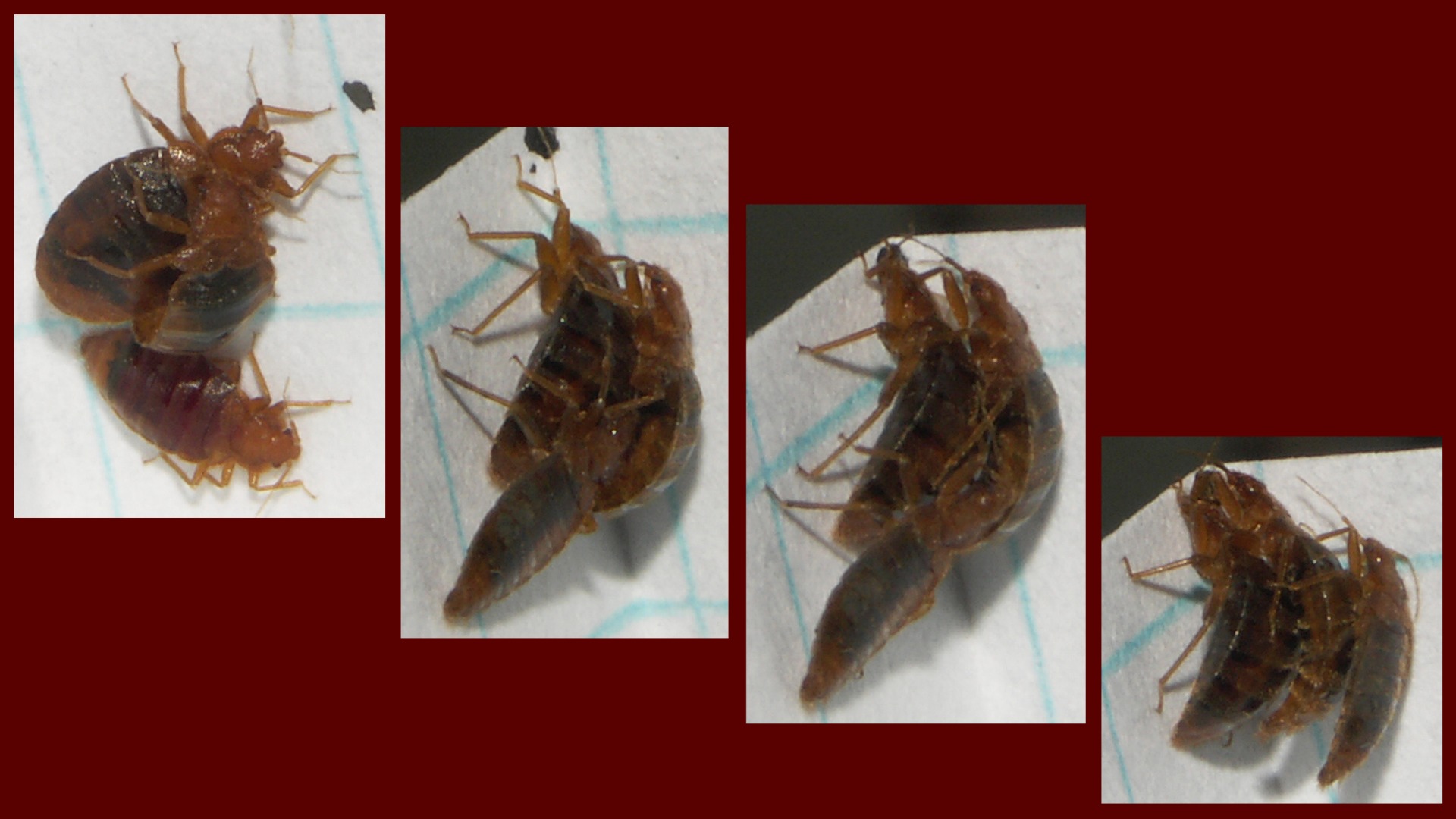
Traumatic Insemination
Start on the top left and view the sequence to the bottom right. Male & female mating with another male just hanging out below. The single male intrudes on the couple, pushing himself between them. Now no one is mating and soon after the threesome parted and all crawled away.
Photo courtesy of Lou Sorkin

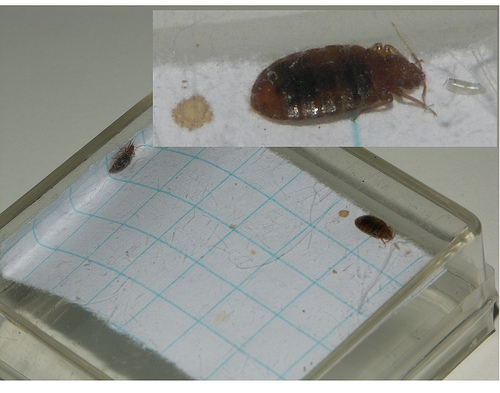
Mated Bed Bugs
Bugs fed and then mated soon after, then 48 hours passed before picture was taken. Male on left, female on right. Sometimes they are together, sometimes apart. Close-up of female shows newly deposited egg on right and waste dropping on left. Note that dropping is pale because it is nitrogenous waste, uric acid, and not digested blood. Even unfed first instar nymphs deposit pale droppings. There are times when the bug will void dark liquid or undigested blood very soon after feeding - possibly if it has taken in a large volume of blood and has to release some. 1/4 inch squares.
Notes and photo courtesy of Lou Sorkin

Adult bed bug with 2 eggs and grains of rice
In this bed bug photo, there is one adult bed bug and two bed bug eggs. The grains of white rice provide relative scale for comparison. An adult bed bug is 5 to 7 mm in length (less than 1/4 of an inch) and the eggs - well, as you can see - very tiny indeed.
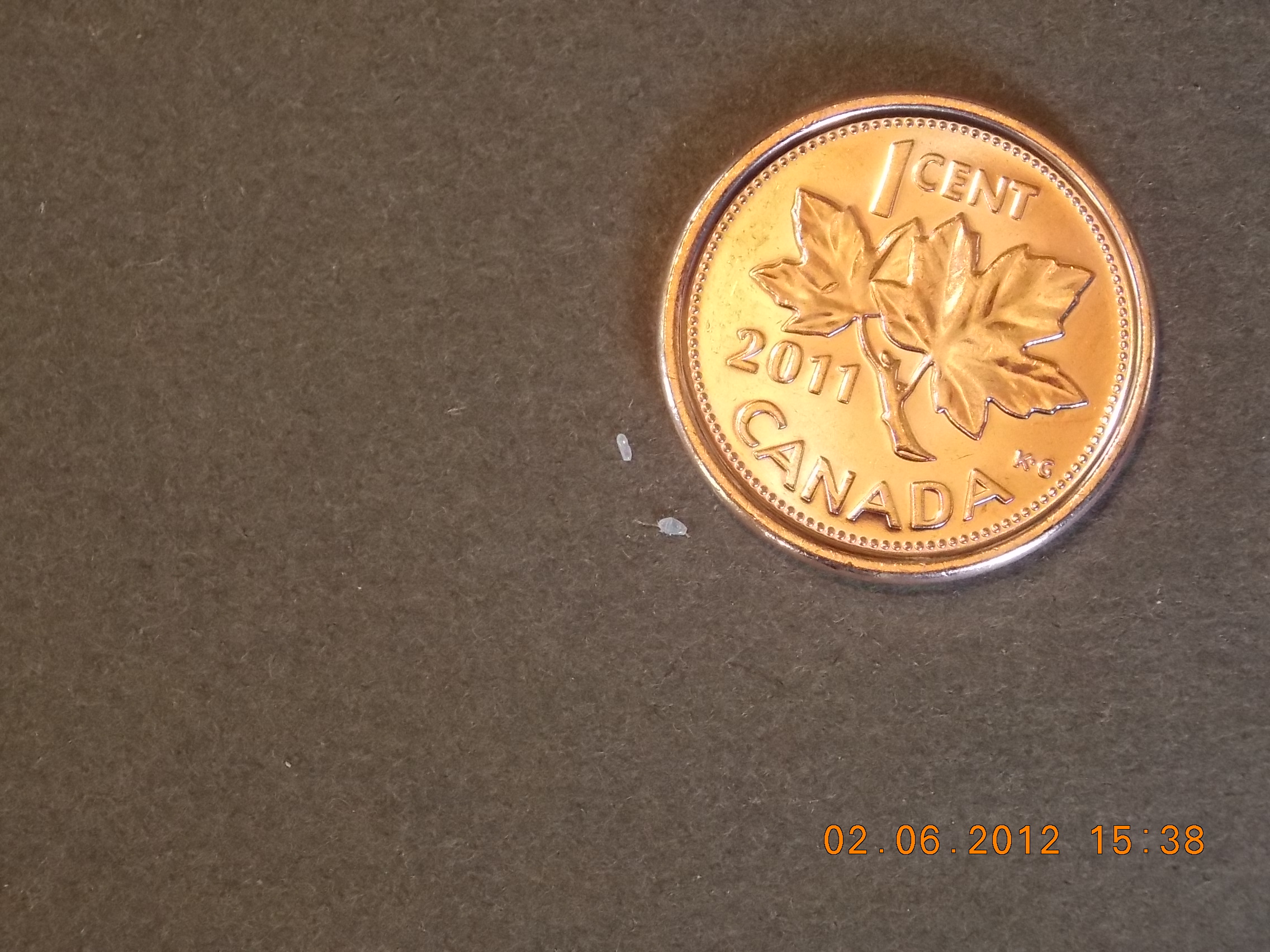
Bed Bug Eggs
Two bed bug eggs alongside a Canadian penny for scale.

Bed Bug Life Cycle
Representation of the life cycle of bed bugs illustrating the changes in size, colour and appearance as they develop from egg to adult.
Courtesy of http://www.bedbugbeware.com

Dorsal view of nymphal (immature) bed bug
Adult bed bugs are on average 5 mm long, oval-shaped and dorso-ventrally flattened. Like other members of the order, Hemiptera, they possess piercing-sucking mouthparts. Adults are brachypterous, which means that the hindwings are nearly absent, and the forewings are reduced to small, leathery pads. As you can see here, nymphs look like smaller, paler versions of the adults.
Courtesy CDC/ CDC-DPDx; Blaine Mathison/2010
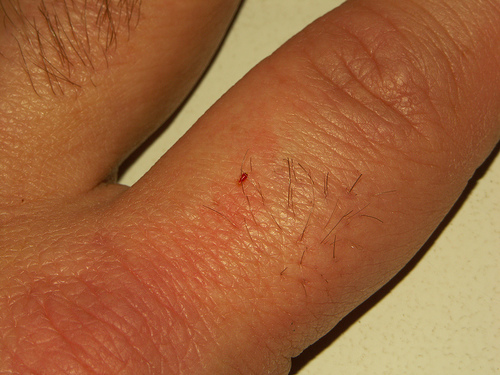
1st Instar Feeding
First instar bed bug on left forefinger while it is feeding.
Notes and photo courtesy of Lou Sorkin
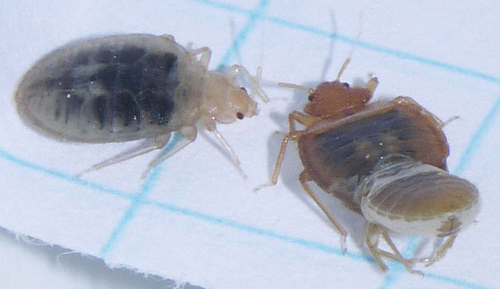
Bed bug cast skin beside bed bug
The bed bug on the right is in the process of shedding it's skin; it remains attached to its rear end. Bug on left recently molted. Notice it is paler, lighter coloration. Both bugs have blood from previous (5th instar nymph) stage still in their digestive tracts. Molting occurs when bug is physiologically ready. It doesn't have to totally digest its current blood meal first. Newly molted adult females may be able to produce eggs and mate before their first adult blood meal.
Scale: 1/4 inch squares. Photo courtesy of Lou Sorkin.
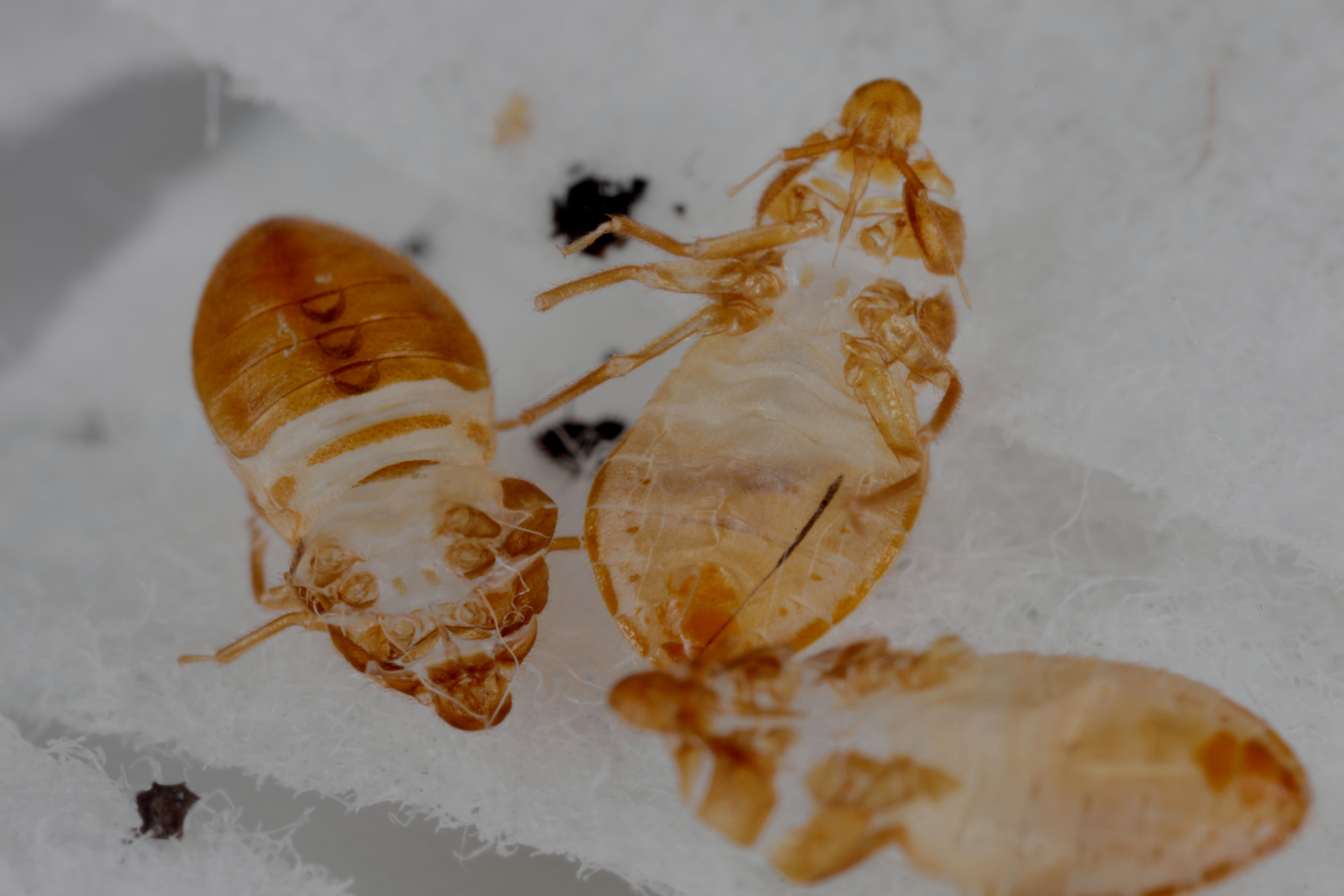
5th Instar Shed Skins
A dorsal, and 2 ventral views of the exuviae or shed skins of 5th instar bed bug nymphs. You can see the 3 dorsal scent gland areas on the middle of 3 dorsal abdominal sclerites in bug on left. You are looking into the bug: the thoracic sclerites split down the center and on head and the adult crawled out. The proboscis is evident as are 2 antennae of the bug on right. Contrast, brightness, gamma settings modified to enhance the sclerotized parts.
Note and photo courtesy of Lou Sorkin
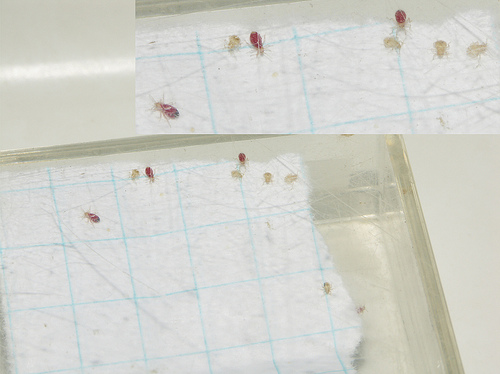
Fed and Unfed 1st Instar Nymphs
Recently hatched bed bug first instar nymphs. Some have just fed and others have not. 1/4 inch squares. The length of an unfed nymph is around the thickness of a credit card.
Notes and photo courtesy of Lou Sorkin
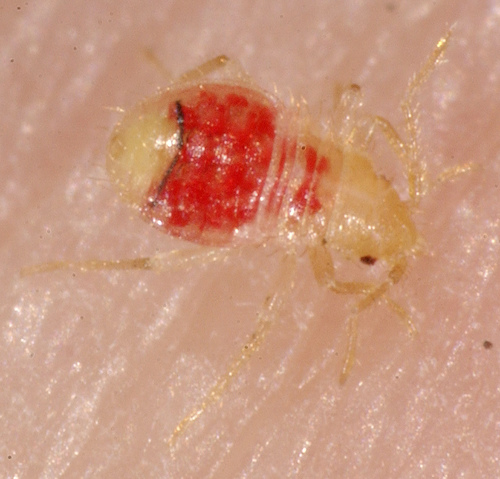
1st Instar Nymph Feeding
Bed bug first instar nymph a few minutes into feeding.
Notes and photo courtesy of Sorkin & Mercurio
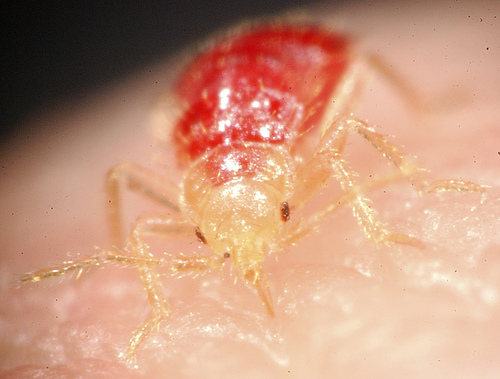
1st Instar Head Shot
Bed bug first instar front view of head and mouthparts while it is feeding.
Notes and photo courtesy of Sorkin & Mercurio

1st Instar Fully Fed & Plump
Bed bug first instar nymph full and getting ready to stop, crawl away and hide.
Notes and photo courtesy of Sorkin & Mercurio
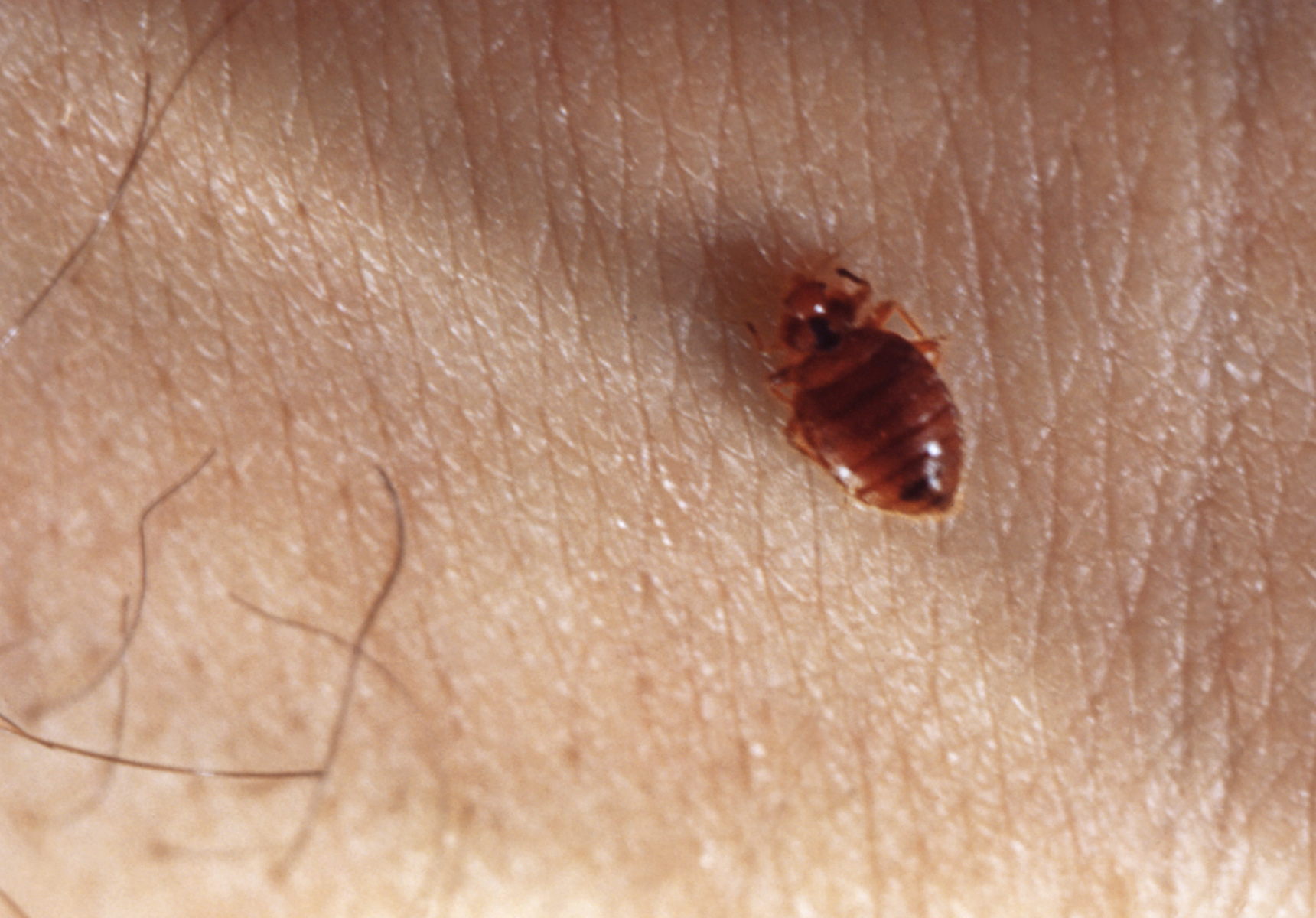
Cimex Lectularius bed bug
Though this insect has not been incriminated in the transmission of any communicable diseases, some people are very sensitive to the bites of this bedbug species, Cimex lectularius, while others are hardly aware of their presence.
Courtesy CDC/1972
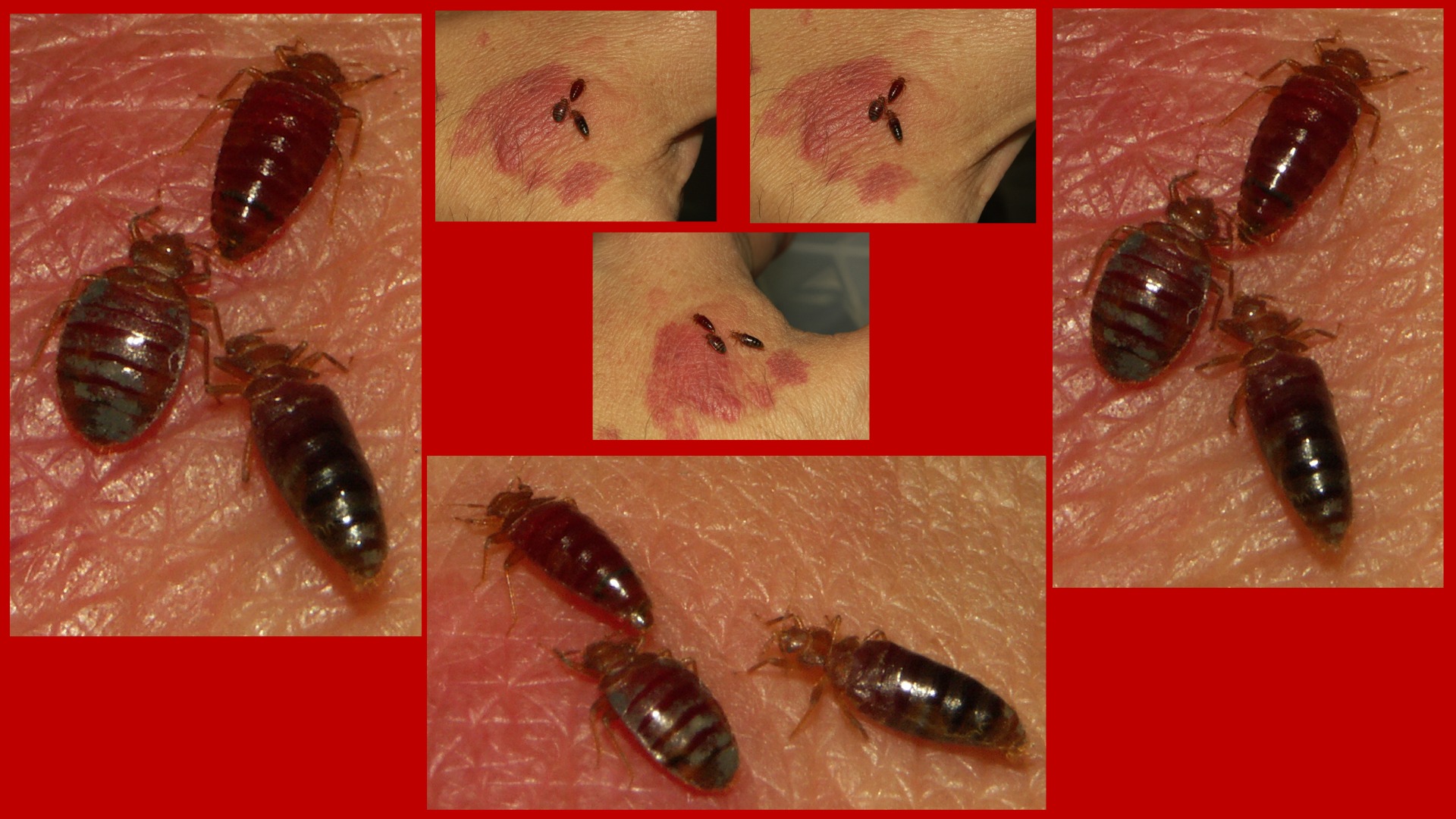
Views of 3 bed bugs as they feed. There are 2 females and one male. One female is easy to identify since it hasn't quite filled up, but the other 2 have become distended with blood and most people would call both males because they are elongate and not a typical roundish shape thought to be characteristic of a female bed bug body. Hint: the female terminalia is symmetrical, while that of the male is not. It is also easy to see the articulated wings on the thorax of one bug.
Photo courtesy of Lou Sorkin
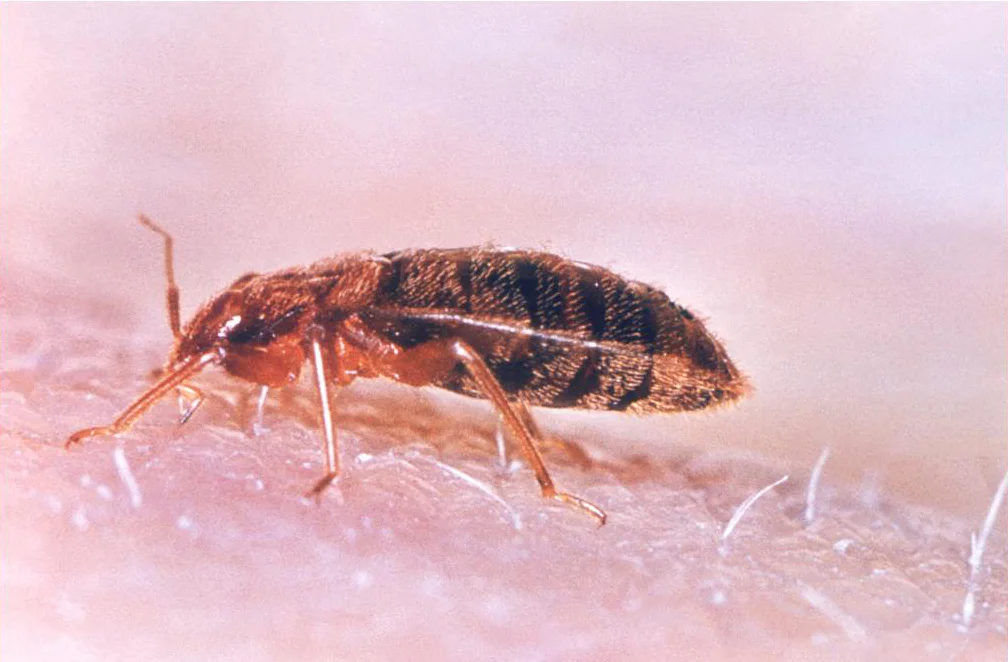
This “common bedbug" Cimex lectularius, uses its mouth parts adapted to piercing skin in order to obtain its blood meal.
The bedbug gets its name from the fact that it often makes its home in and around a bed, in the mattress, box spring, and even the bed frame itself. It feeds at night while its host sleeps, and can obtain its blood meal in as little as 3 minutes.
Courtesy CDC/ Donated by the World Health Organization, Geneva, Switzerland/1976
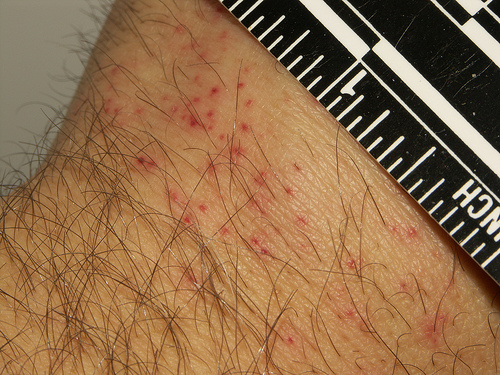
Bite Marks Hours After Feeding
Bed bugs will crawl along hairs and crawl down to skin surface to feed. Hours after bed bug feeding, red marks appear at site of each bite. Welts had preceded the red marks but first disappear. Red marks severity lessens with age and in a week are gone. Microscopic brownish areas remain but are very difficult to clearly see.
Notes and photo courtesy of Lou Sorkin
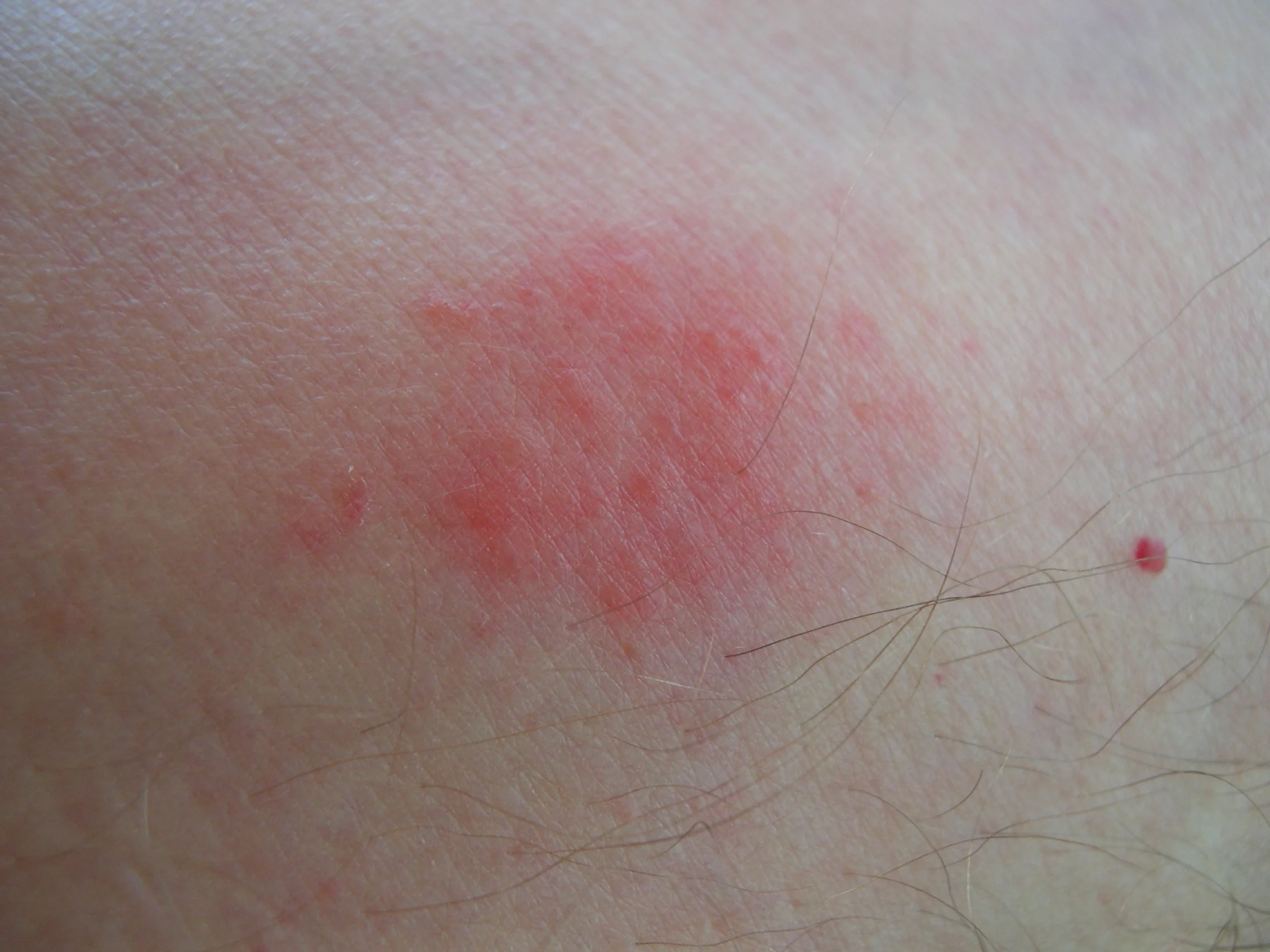
Bed Bug Bite Marks (1 of 3)
Allergic reaction 24 hours after feeding a dozen bed bugs.

Bed Bug Bite Marks
4 bite marks, 24 hours after feeding.
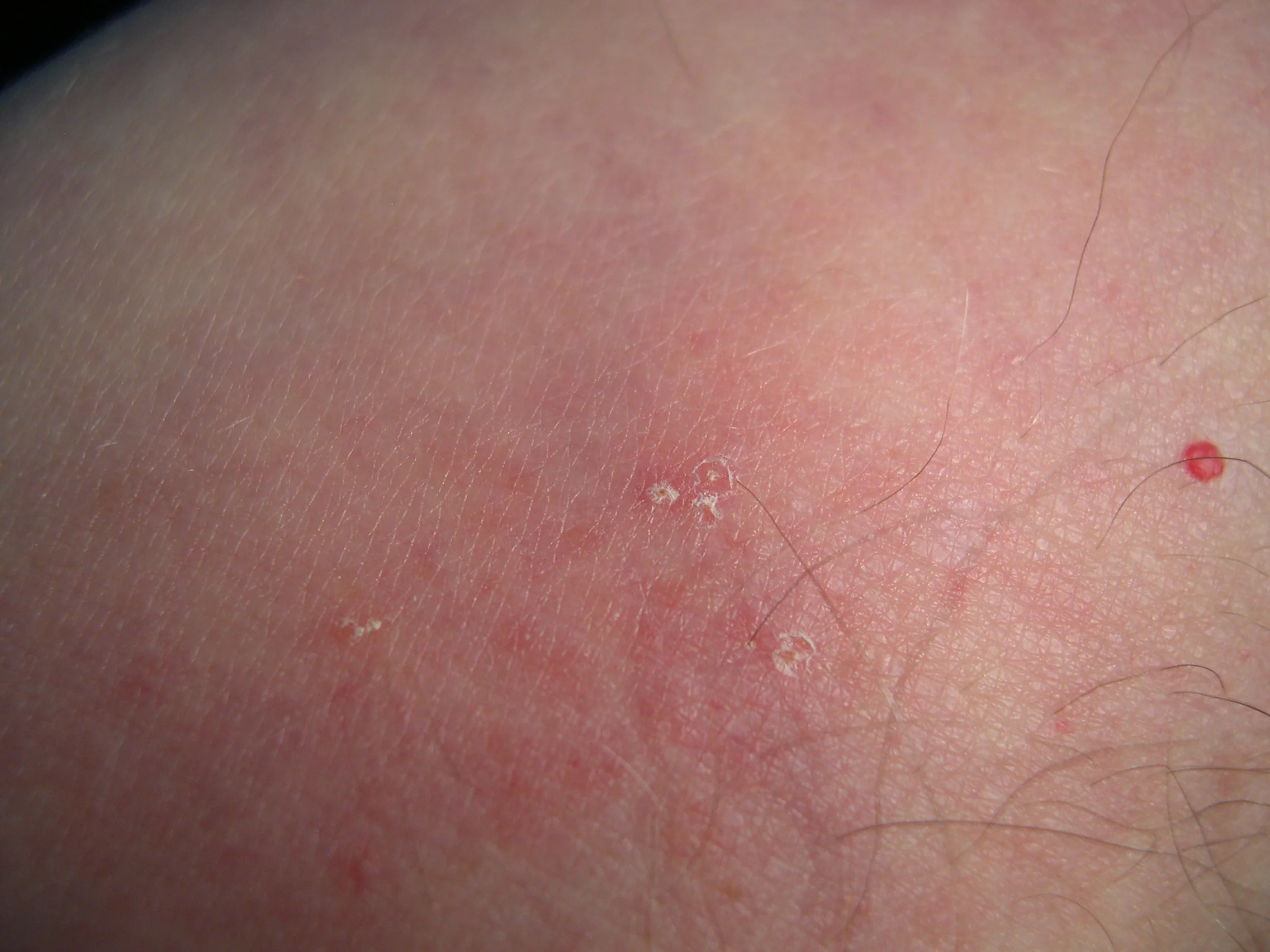
Bed Bug Bite Marks (2/3)
Allergic reaction 48 hours after feeding a dozen bed bugs
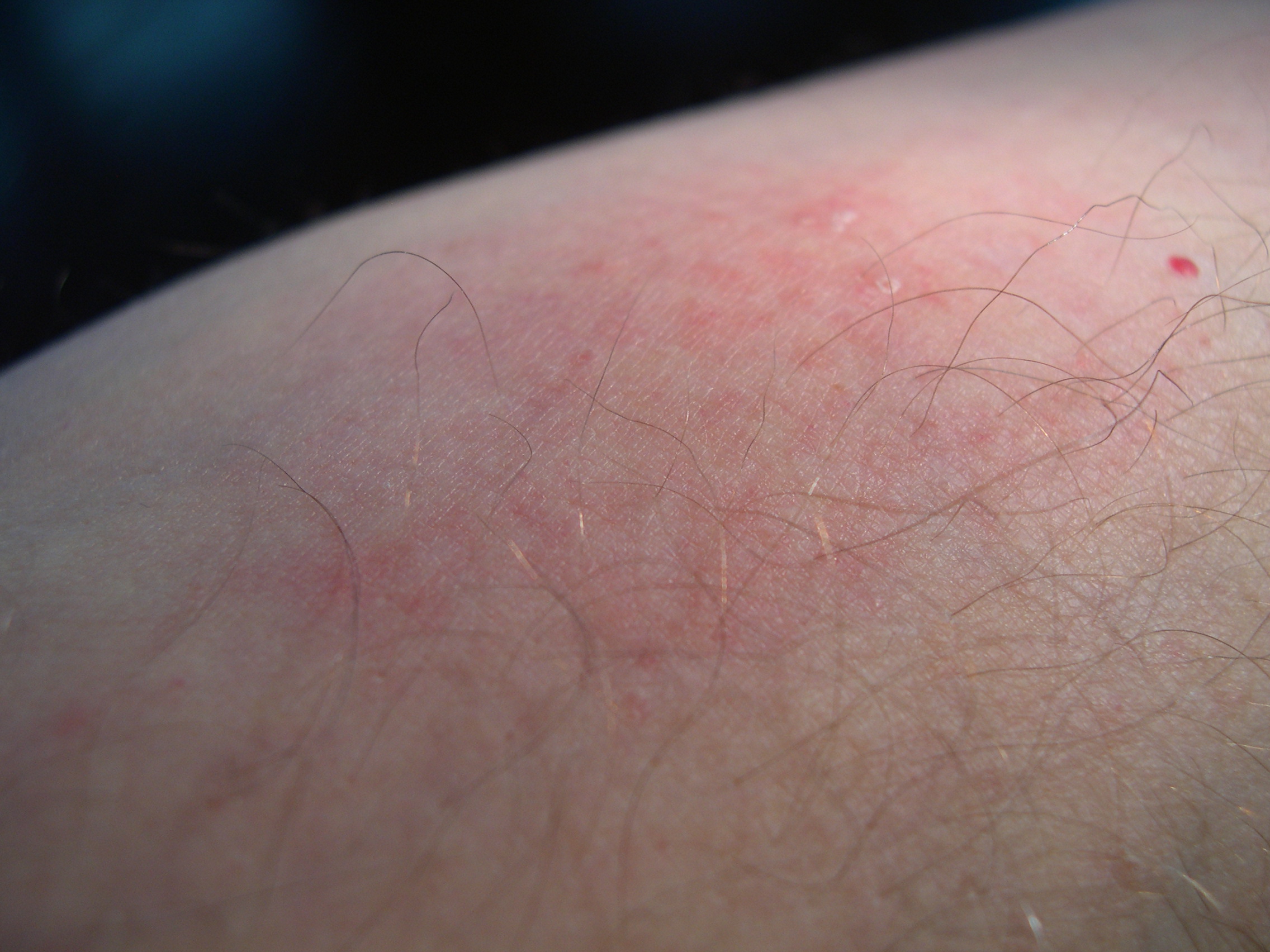
Bed Bug Bite Marks (3/3)
Allergic reaction 3 days after feeding a dozen bed bugs.
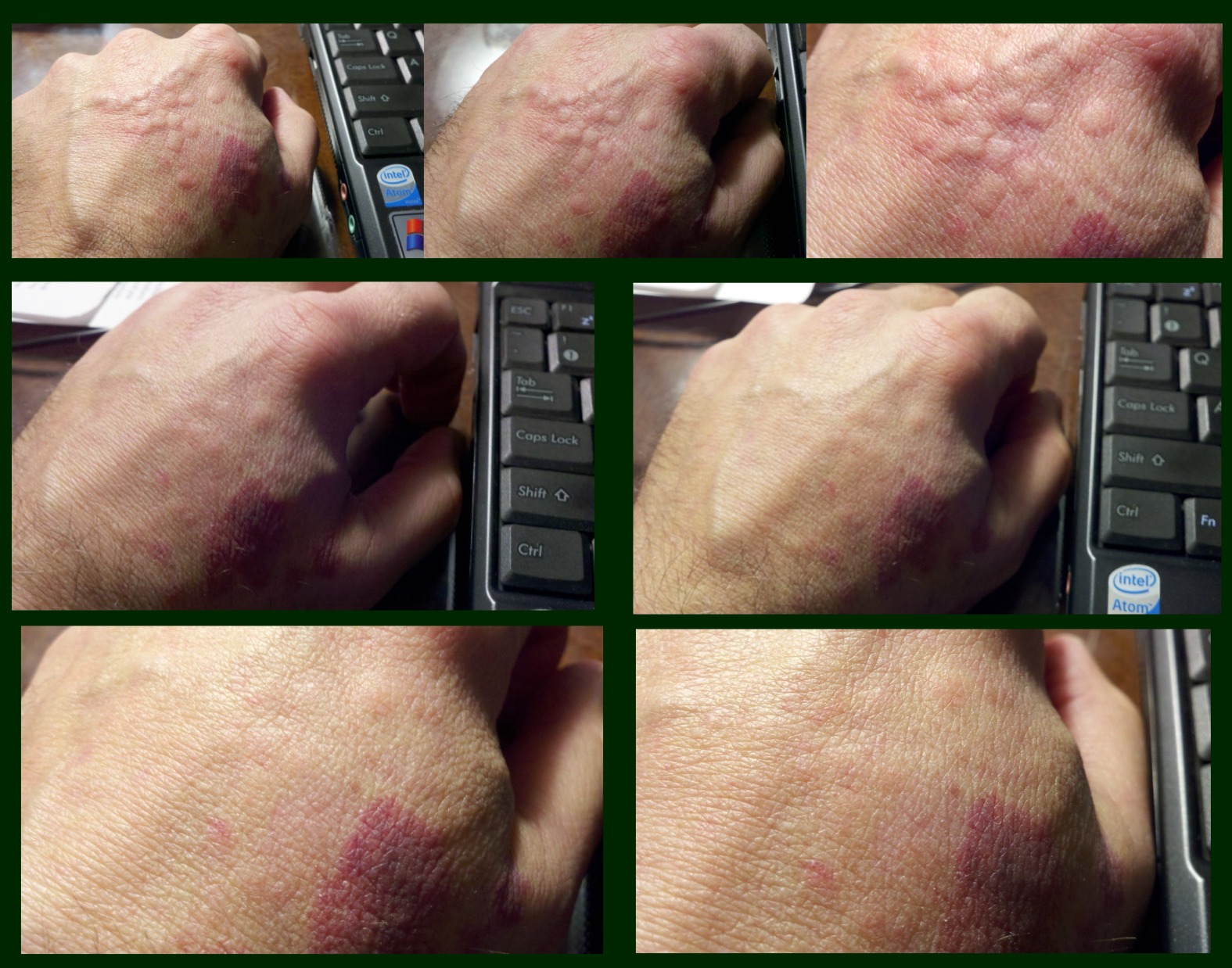
Bite Mark Reaction Over One Hour
Images of bite reaction a little over one hour from feeding, reactions, to almost no visible reaction. I don't experience itching. Red blotch is the nevus birthmark, not related to bed bug feeding.
Photo & comment courtesy of Lou Sorkin
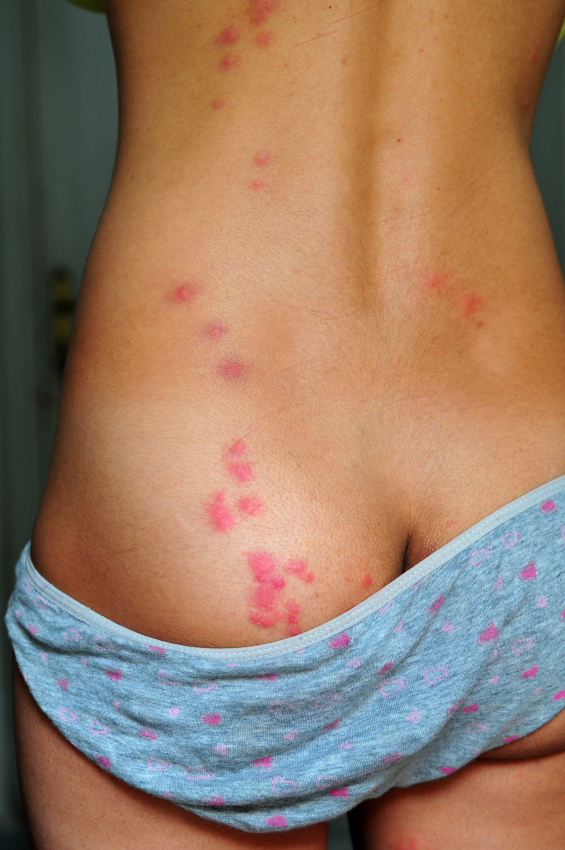
Bed Bug Bite Marks
The bite mark is an allergic reaction to the saliva released by the bed bug. Not everyone reacts because not everyone is allergic, and like all allergy reaction, responses vary between individuals.
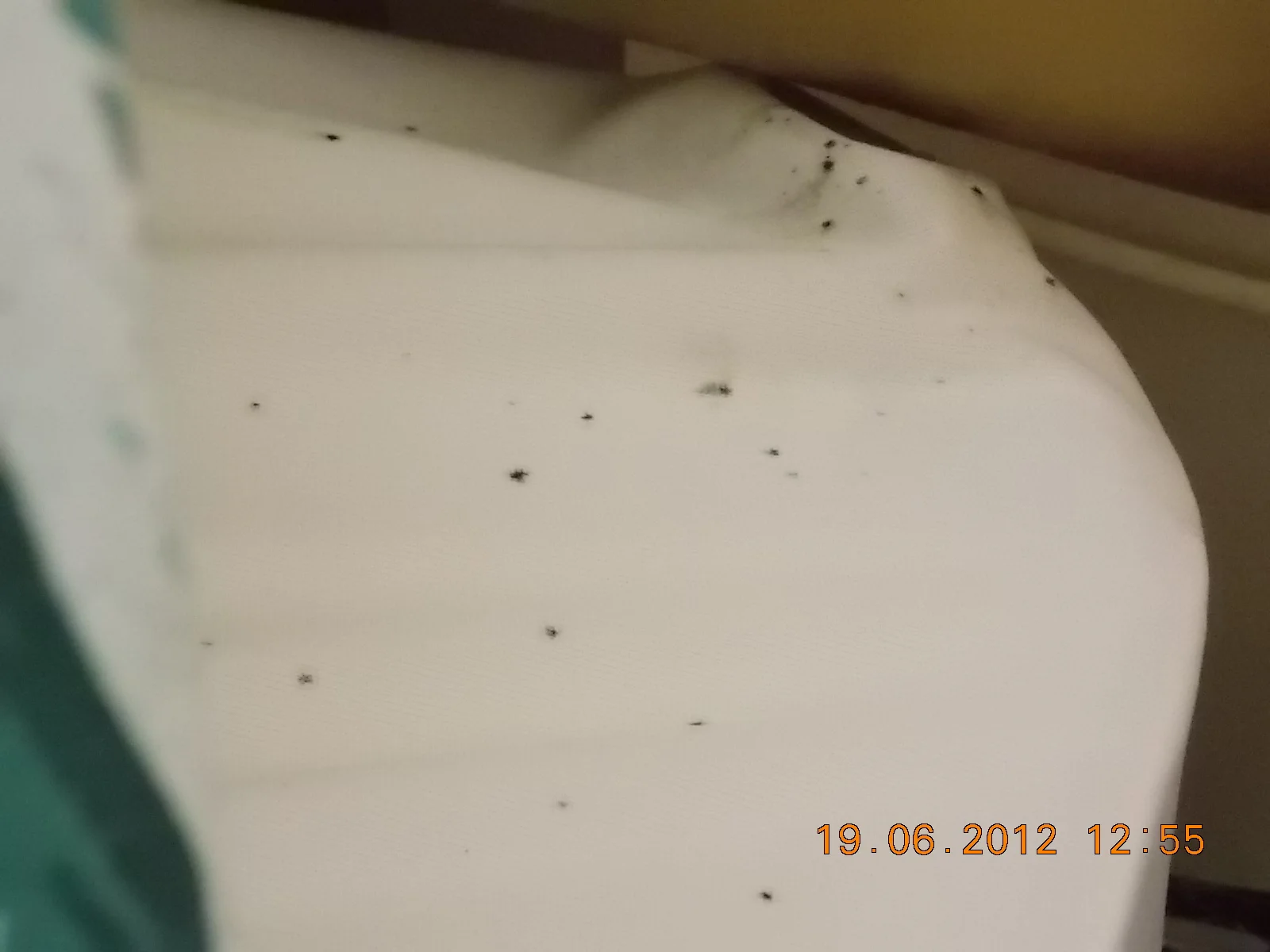
Bed bug fecal marks
These black spots are indicators of the presence of bed bugs.
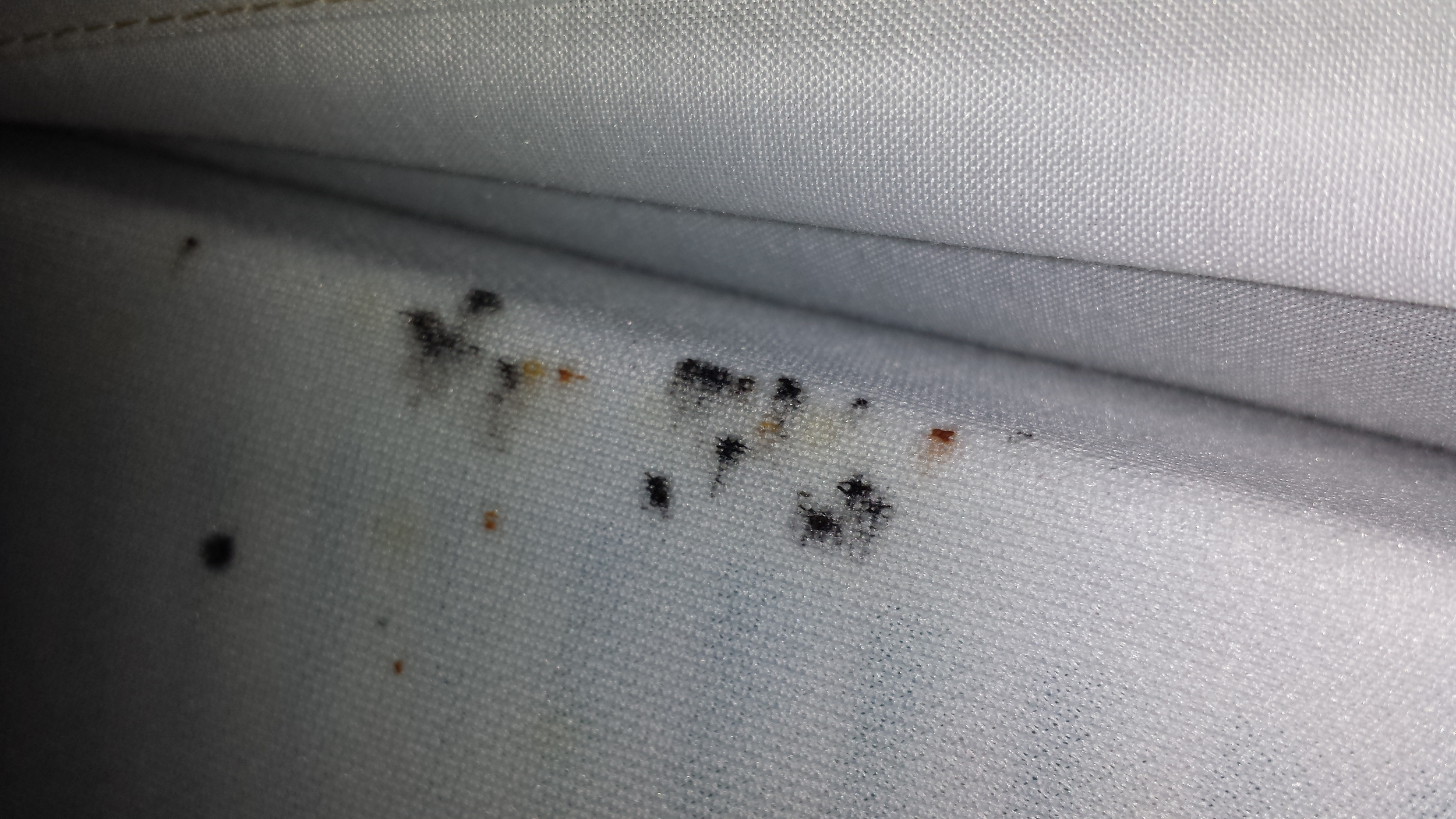
Bed bug fecal
The tell-tale signs of the presence of bed bugs - the black fecal spotting of digested blood meals, bed bug 'poo'. This is a close-up of a box spring encasement showing the fecal along the top edge of the box spring, just below where the mattress sits on the supporting box spring. Note encasements do not prevent an infestation, though a snug fitting one can make it easier to spot fecal marks and protects the underlying material from bed bug fecal stains.

early detection of bed bug infestation
Fecal spotting along mattress seam

Bed bug infestation
Fecal, shed skins and live bed bug nymphs can be seen along the mattress seam.

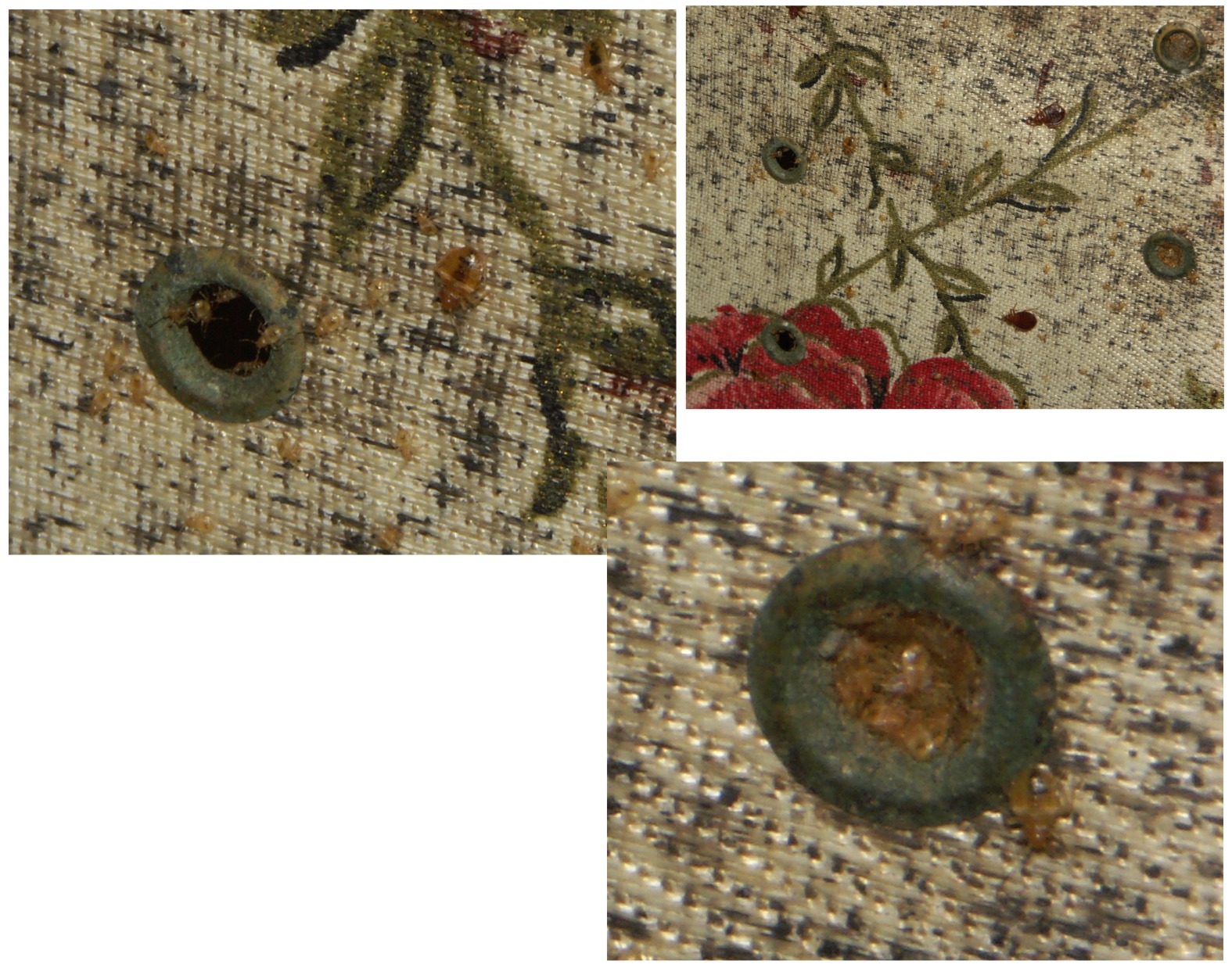
Box Spring Harbourage
Box spring with with 2 air holes cluttered with bed bugs. Top right image is general view, while top left is left air hole and bottom right is right air hole. A large bed bug is visible on right side of left air hole, but close up reveals tiny first instar nymphs. Bed bugs are "hiding" in plain sight on right air hole.
Notes and photo courtesy of Lou Sorkin
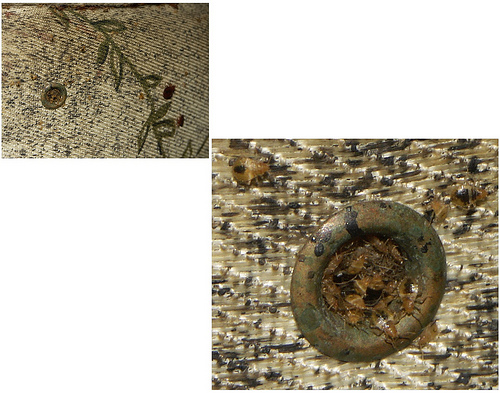
Hiding in Plain Sight
Box spring air hole and close up to show bed bugs "hiding" on an exposed surface and are not really in a hidden harborage site.
Notes and photo courtesy of Lou Sorkin
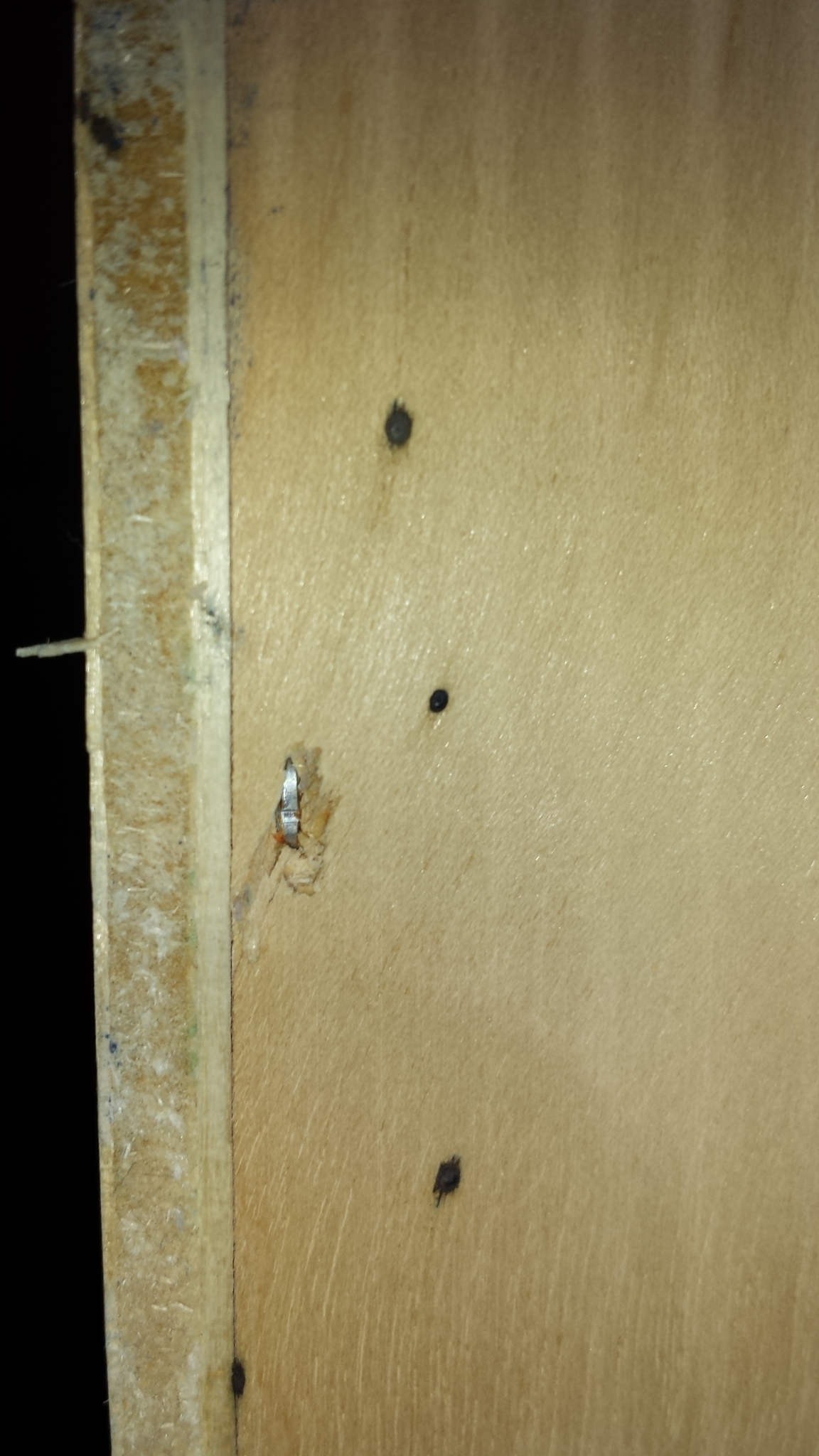
Bed bug fecal on underside of bed platform
Four fecal marks left by a bed bug hiding on the underside of the wooden bed platform. Bed bugs are able to poop upside down!
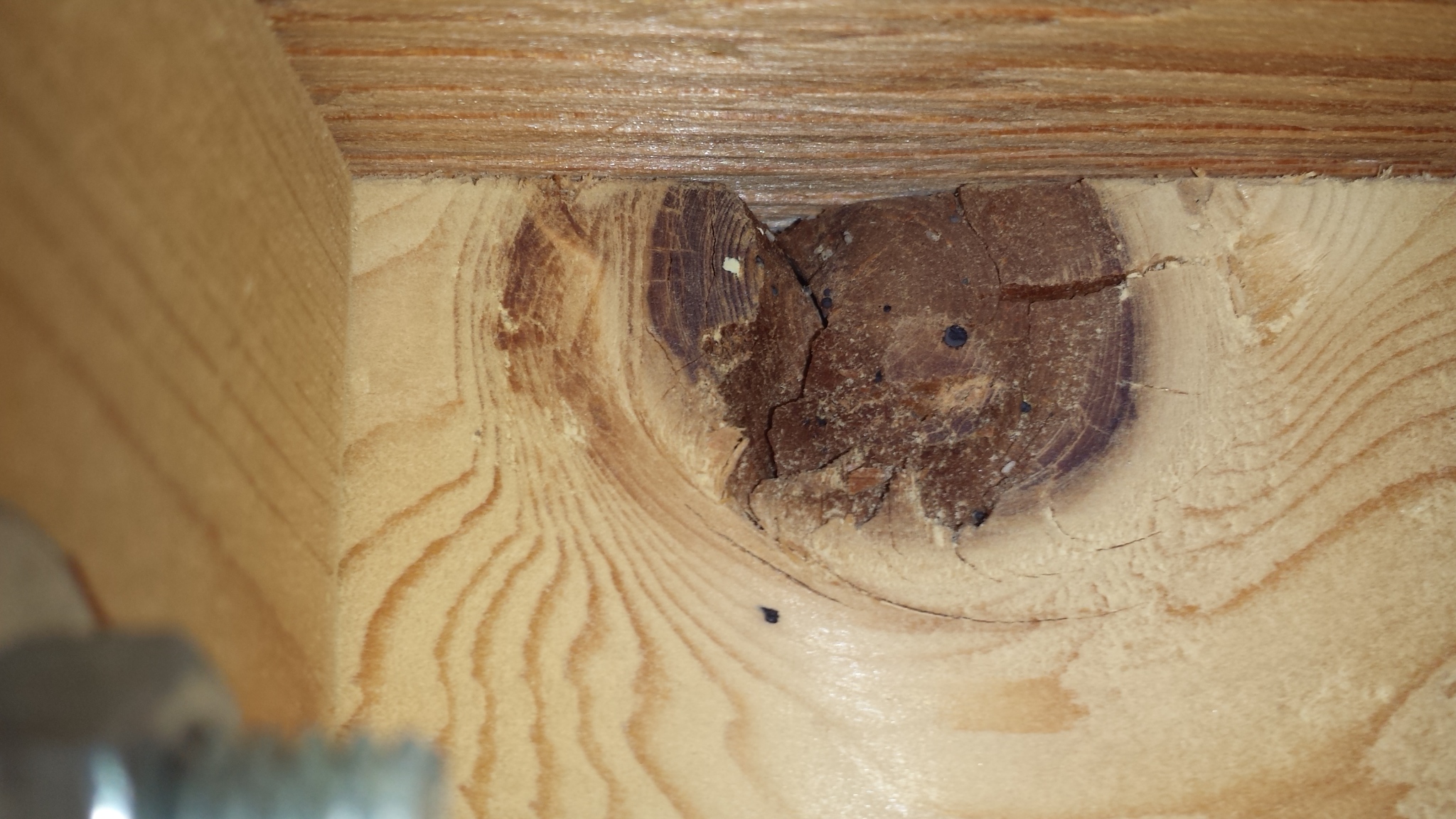
Bed bug harbourage
Underside of top bunk reveals evidence of a bed bug harbourage. There are several black fecal marks and several eggs glued on the rough raw wood of the crevices in the knot.

Bed Frame Harbourage
Bed bug waste (feces are dark and uric acid excretion is pale), shed skins, eggs (some entire, some hatched) on underneath side of bed slat.
Notes and photo courtesy of Lou Sorkin
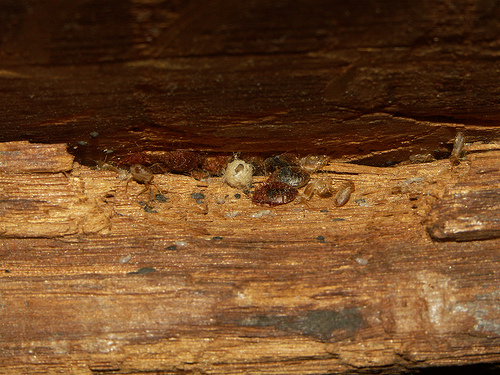

Hiding in Decorative Wood
Bed bug nymphs, shed skins, feces near to and in the groove.
Notes and photo courtesy of Lou Sorkin
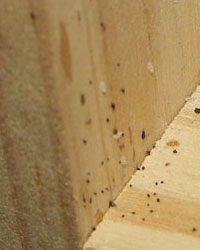

CD Case Harbourage
CD shelf with some cases removed shows different sized bed bug nymphs, eggs and feces attached to wood. Some feces might be from german cockroaches.
Notes and photo courtesy of Lou Sorkin
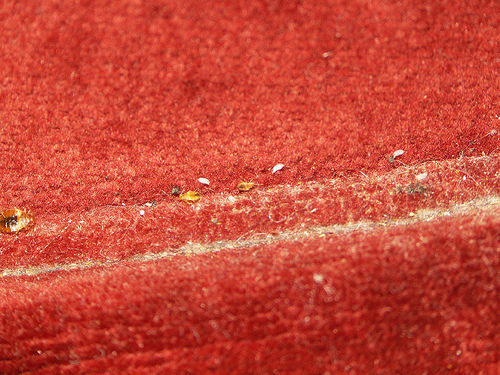
Bed Bugs Hiding In Seam
Close up of some bed bug hatched eggs, second and first instar nymphs. First instars are 1mm or 1/32 inch long; second instar about 3 times that.
Note and photo courtesy of Lou Sorkin
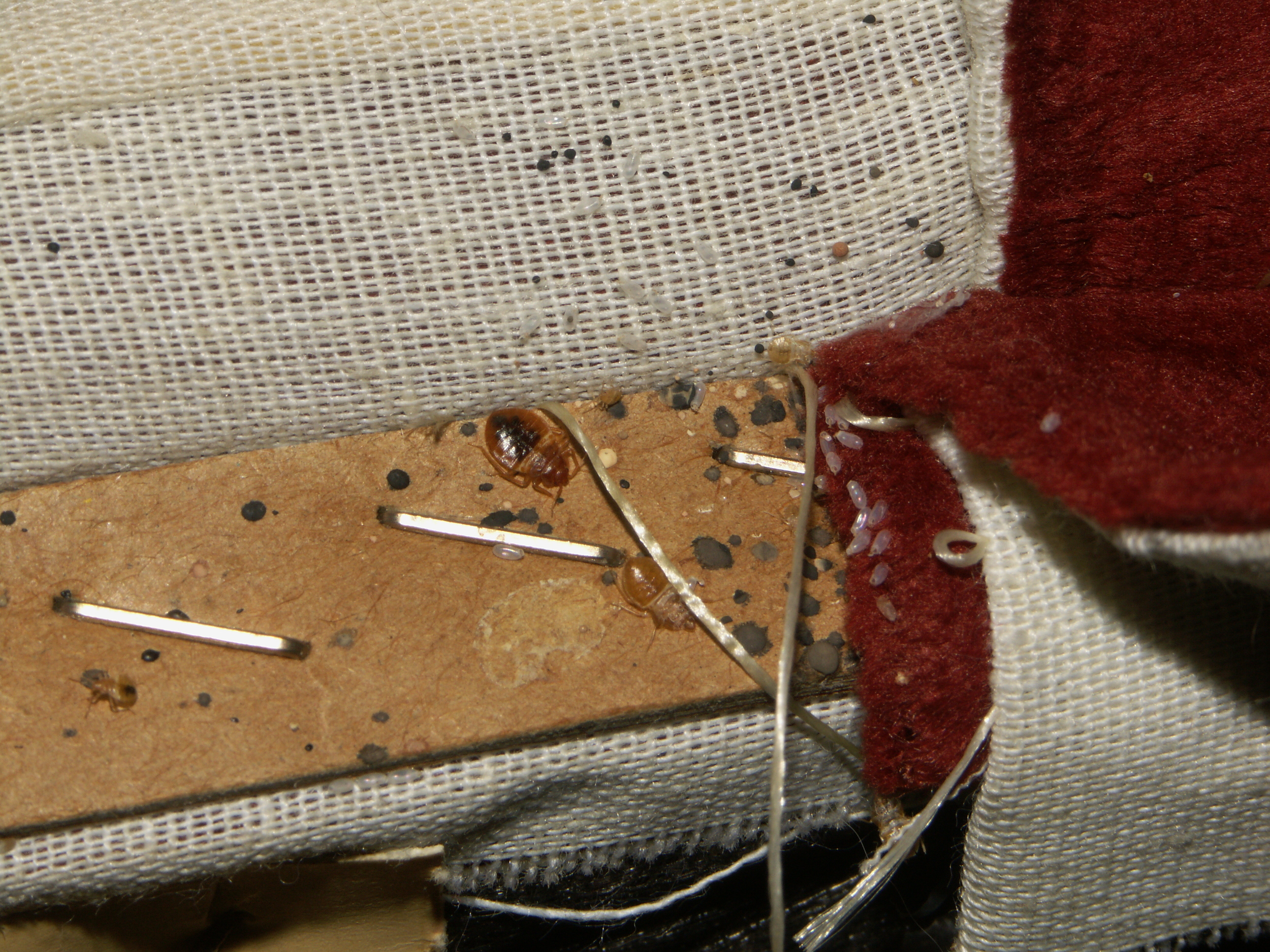
Hiding in Upholstery Staples
Bed bug nymphs, shed skins, eggs (hatched ones with cover popped open), and feces. Eggs are around 1mm or 1/32 inch long.
Notes and photo courtesy of Lou Sorkin
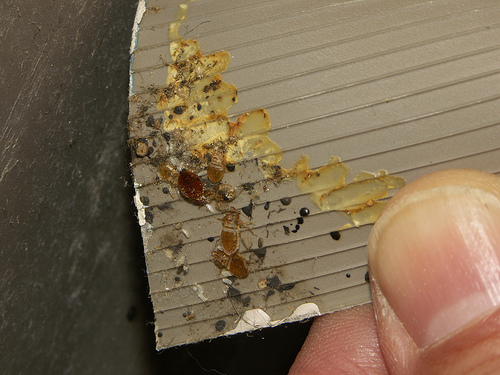
Bed Bug Harbourage
Flat rubber molding pulled back to reveal bed bugs hiding. Notice that bugs are at top of molding in corner where there is no adhesive.
Photo courtesy of Lou Sorkin
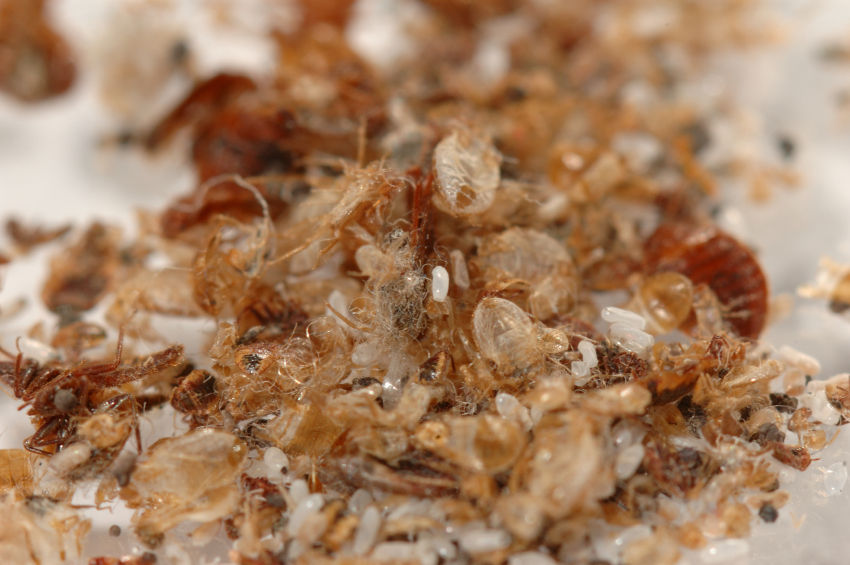
Bed Bug Debris
Pile of cast skins and eggs
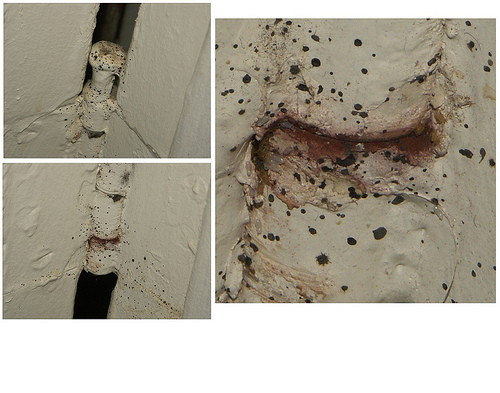
Door Hinge Harbourage
Bed bug harborage on painted door hinge with close up of lower part of hinge to show bed bug nymphs, eggs, fecal drops in open space of hinge.
Notes and photo courtesy of Lou Sorkin

Plastic Chair Harbourage
Bed bug harborage site in recessed screw hole on side of textured, molded plastic desk chair. See bugs, shed skins, eggs, and light and dark droppings. Light ones are uric acid (excretory) deposition and dark ones are fecal blood drops. Note that these bead up on the plastic rather than get absorbed which would happen on most fabrics. Opposite side of chair had no bed bugs in the screw hole. Person probably put coat or other clothes on right side of chair.
Notes and photo courtesy of Lou Sorkin
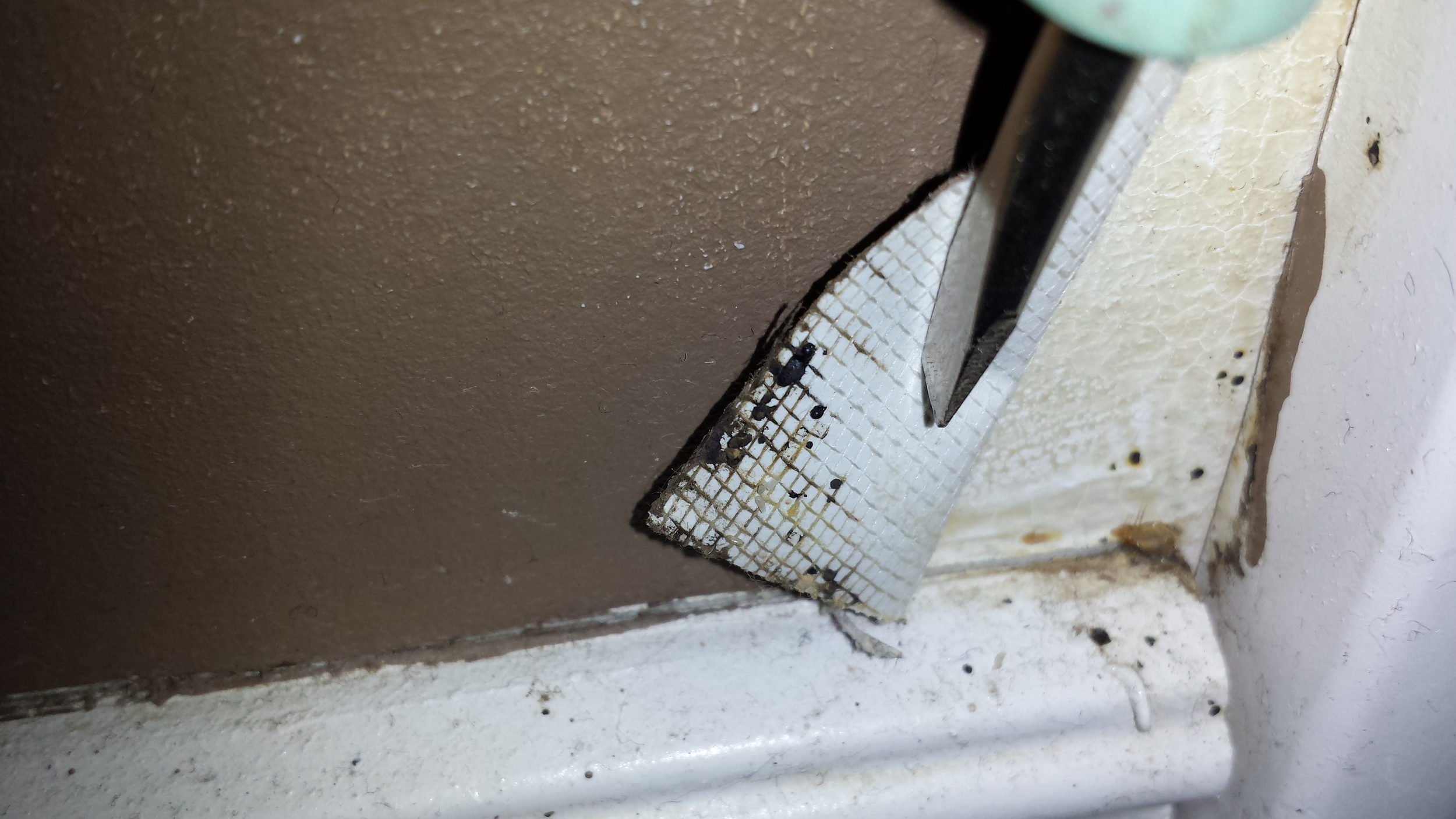
Bed bug fecal
Fecal marks are visible on top edge of the baseboard as well as underneath the wallpaper corner which has been lifted. Note there is even fecal marks on the backside of the wallpaper.
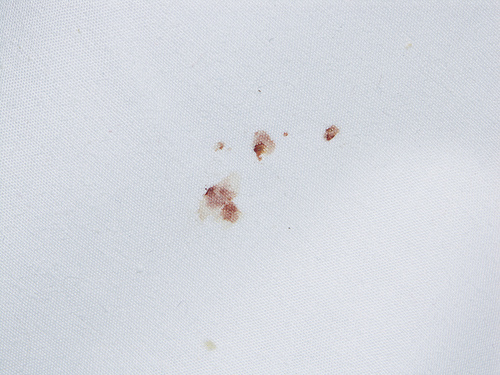
Blood Smears Not Conclusive of Bed Bugs
Blood smears on bed linens should not be used as conclusive evidence of the presence of bed bugs. It is merely an indication of something and should not be confused with bed bug fecal marks - which are dark brown or black in colour.
Photo courtesy of Lou Sorkin

Bed Bug Or Louse?
P=Pediculus (louse)
C=Cimex (bed bug)
Notice that the smallest louse is smaller than a first instar bed bug nymph.
Also a louse in the group on the left middle area of picture is defecating, a behavior that contributes to it being an important insect vector for louse borne diseases. Defecation on the host and the host scratching introduces the disease organism into the excoriated skin.
Notes and photo courtesy of Lou Sorkin
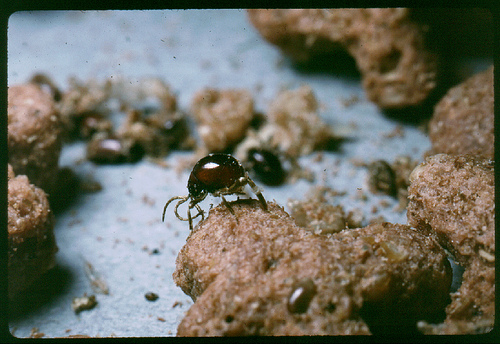
Hump Beetle Or Bed Bug?
NOT a bed bug, but a beetle called Gibbium aequinoctiale. Its common names are hump beetle, shiny brown spider beetle and it's a scavenger and stored product pest. Most often confused with bed bugs because of its reddish brown color and globular shape causing people to think that it is full of blood -- it is not.
Note and photo courtesy of Lou Sorkin
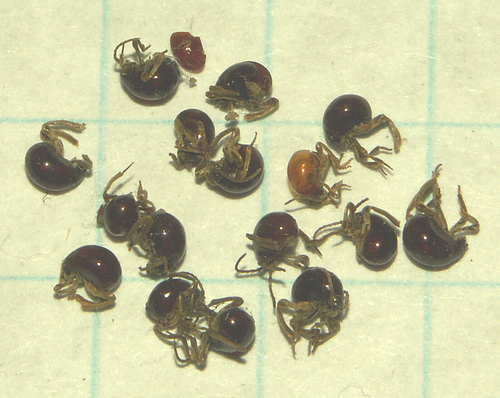
Bed Bug Or ?
THIS IS A TEST OF YOUR BED BUG IDENTIFICATION SKILLS.
If you said 'hump spider beetles' you'd be RIGHT!.
There are, indeed a collection of dead hump spider beetles; NOT bed bugs.

Carpet Beetle Larvae
Carpet beetle larvae are often mistaken for bed bug nymphs. This one was found behind the bed headboard. Some individuals have an allergic reaction to their hairs which mimics a 'bite mark', further adding to the confusion.
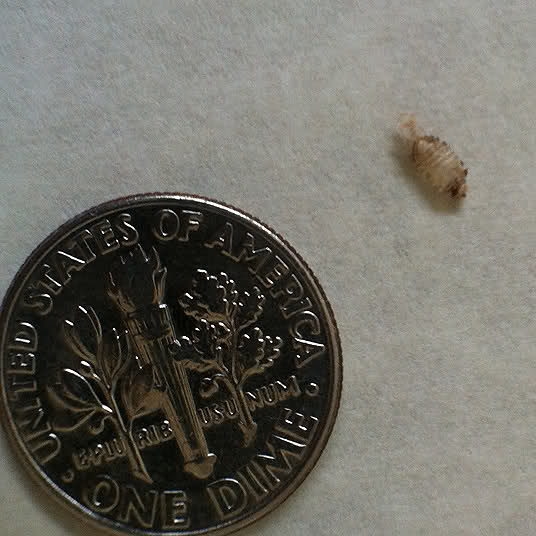
Bed Bug Or Look-A-Like?
Carpet beetle larvae
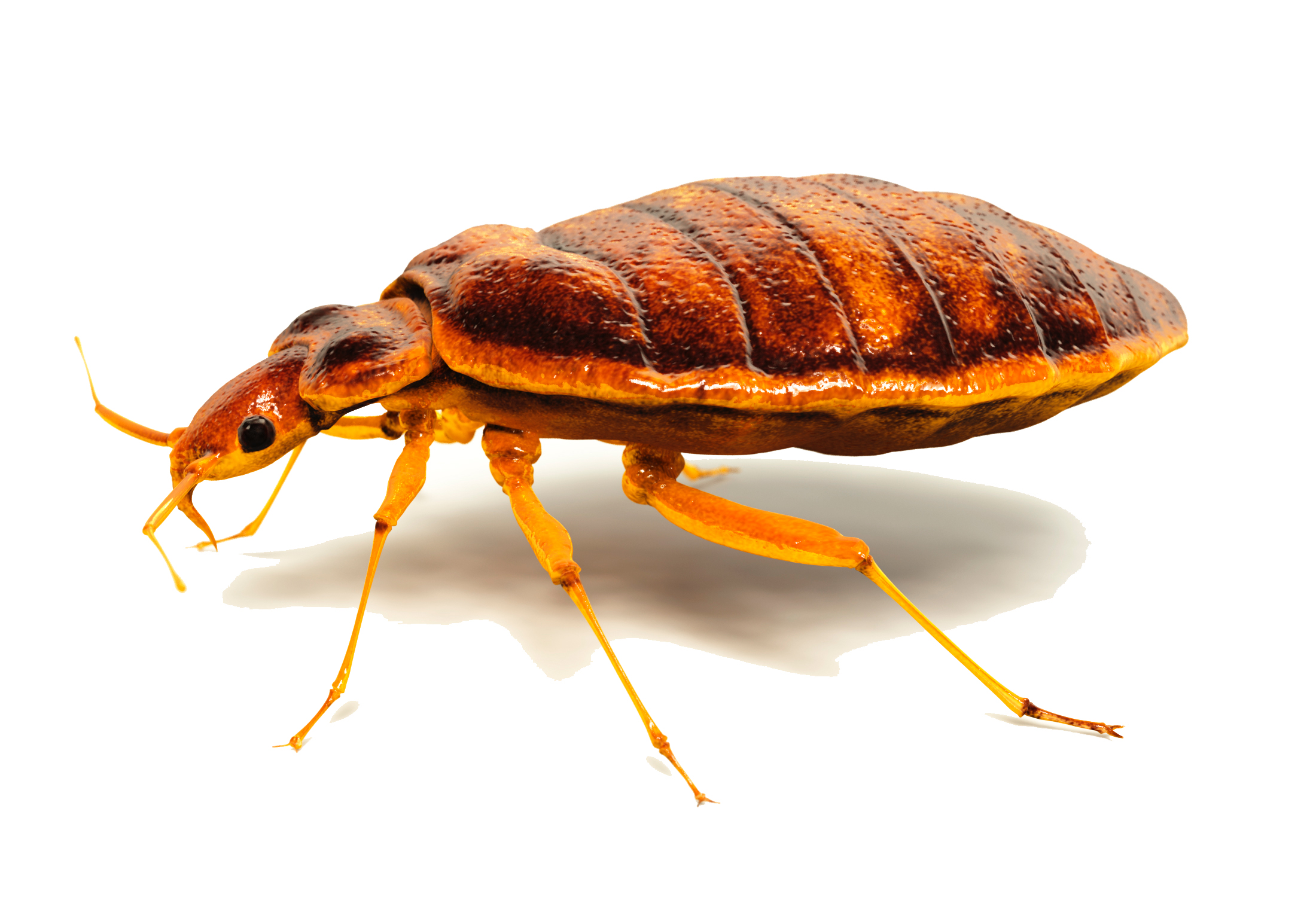
Bed Bug Side View
Detailed illustration of an adult bed bug.





























































